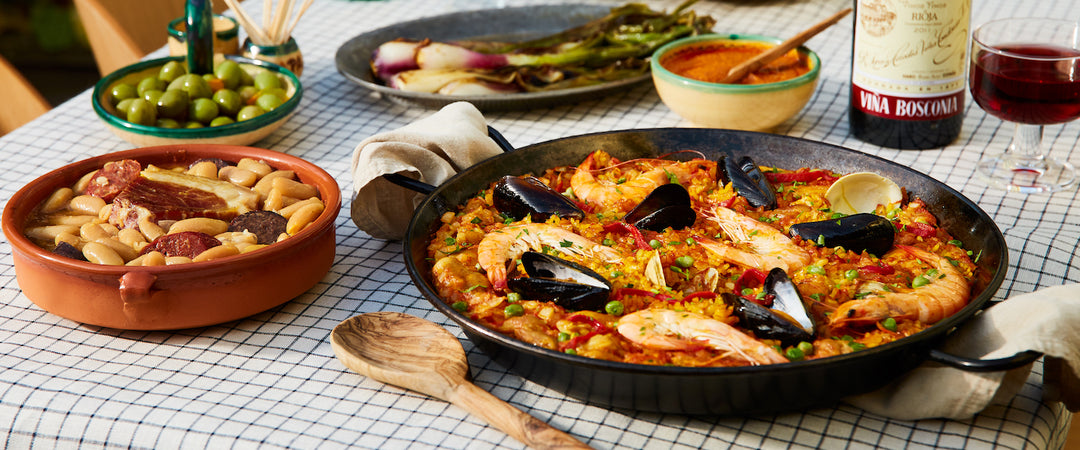May 2024 Blanco Y Tinto Wine Club
 |
Viña Ijalba 2022 Maturana BlancaRegular Price: $25.99
Club Price: $22.09
|
This month our team was as inspired by some of the “meta” information as by the wines. Some were inspired by the beautiful flower-themed labels to focus on Mother’s Day. I wanted to share how we came to “stack” our wine club with a single winery this month, and why this white is so particularly interesting.
Our selection process always involves tasting. Often, we select wines from multiple tastings with different local sales reps. Last month we were visited by Alfonso Fernandez, export manager at Viña Ijalba in Logroño (the administrative and commercial heart of the Rioja region). We were familiar with the Maturana Blanca, as it’s been their only wine on our shelves. But after re-tasting it with Alfonso, and with this being a new vintage, not to mention both its inner and outer beauty, it had to be ‘the one’ for May.
Ijalba, small(ish) and still family-owned, has a fascinating “origin story”, proudly told by the winery itself: “Dionisio Ruiz Ijalba planted his first vineyard in 1975 on a former open-cast mine. Onto this land, already exhausted, he added some 50 or 60 cm. of poor soil, which came from land clearance, and in this way he reproduced the traditional soils of quality Rioja vineyards, which had low production, typical of the area - land on the hillsides which was shallow and relatively infertile.” While most just inhabit landscapes formed by millions of years of geology, Dioniso literally made his own terroir.

Ijalba focuses on two aspects: organic farming and the revitalization of rare grape varietals. This Maturana Blanca, their Graciano (see other writeup), and their Maturana Tinta (in our Tinto Club) are all outstanding - Riojan in character, but unique in flavor and body. Ijalba was and remains the first to make them into single-varietal wines, sourcing grapes from near Logroño, San Vicente de Sonsierra, and Valle de Iregua.
This wine is truly unique. Maturana Blanca is best and most simply described by “if Chardonnay and Albarino had a baby”. According to the Rioja D.O’s official website (https://riojawine.com/), the varietal dates back as far as 1622. It is a light-skinned grape with high acidity, possibly a white variant of Maturana Tinta. It’s essentially never made into a single-varietal wine, but this bottling shows what the grape is capable of in good hands. When well-chilled, honeysuckle, honey, and a very light baked pineapple make for a very pleasant nose. There is a hint of tropical fruit like with Albarino, but it’s understated.
The palate is where the fun really begins. Tastebuds are greeted with an amalgamation of baked pear AND fresh apple hovering over a flowery herbaceous backdrop. I usually associate some of these flavors with Chardonnay, but the overall mouthfeel, acid and ‘freshness’ levels are unlike Chardonnay. The finish is crisp and mineral, but without the bracing tartness of most Albariño. It displays all of the Burgundian richness of Viura-based Rioja whites, but with a whole other dimension added. It is interesting to read that this grape is susceptible to Botrytis, the “noble rot” often allowed to grow on grapes used for Sauterne late-harvest wines. I swear I can smell and taste a hint of it, but then, maybe you smell what you read.
When the wine warms up, it further changes character, with candy-apple notes and even cotton candy emerging in the nose, with the palate shifting to a chalky firmness. All in all, this is a perfect wine for a wine club, where exploring new and unfamiliar territory is part of the fun. To bring it back to the ‘meta’ of the label and Mother’s Day - if your mom likes wine, this might just be the wine to give her. Unique, beautiful, impressive, diverse, multifaceted, getting better with age in the glass, just like your mom. - BMS
 |
Viña Ijalba 2021 GracianoRegular Price: $25.99
Club Price: $22.09
|
When selecting wines for the Tinto Wine Club, we usually focus on winemakers pushing the boundaries of tradition, something the winemakers at Viña Ijalba have been doing since the 1970’s, when the Ruiz Ijalba family planted their first vines in Rioja. With this wine they introduced us to a “new” grape, really a very old grape - Maturana Tinta, a variety exclusively planted in Rioja which nearly fell into extinction. It’s related to a French grape called Castets, which is now gone.
Its French cousin is lost, but this is a comeback story. In 1988, Viña Ijalba, in collaboration with a government regulatory council and the University of Rioja, initiated a project aimed at enhancing the quality, diversity, and protection of Rioja wine. By 1993, they had planted an experimental vineyard with 100 different varieties. Out of this vast field, Maturana Tinta showed promise. In 1997, Viña Ijalba planted its first Maturana Tinta vineyard, and introduced Rioja’s first 100% Maturana Tinta wine in 2003, the first all-Maturana Tinta in the world.
The grape has proven to be a hardy varietal, following a growth cycle similar to Tempranillo. The wines have a rich, deep garnet color due to the high concentration of a natural phenolic compound called anthocyanins, and the grape shares some similar flavor profiles with varietals like Cabernet Sauvignon and Merlot. Typically high in acidity, it yields wines with medium to high alcohol levels with a lot of character and complexity. As soon as it poured into the glass with its deep garnet color, I knew I was in for a rich experience.
The aroma is a flavor explosion—hints of cocoa, vanilla, and spice mix with the scent of black fruits like black cherry, black currant, and black plum. Thanks to some seriously skillful winemaking it's got a balanced, round, elegant, feel and despite appearing very concentrated, is surprisingly medium-bodied with a nice kick of acidity, just the right amount of tannin and a medium-long finish. Pair this with a hefty charcuterie board of cured meats, spicy sausages, and a country pâté. Or even better, a smoked Ribeye with garlic mashed potatoes. - JL



